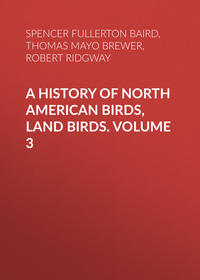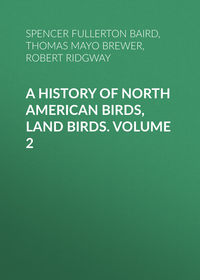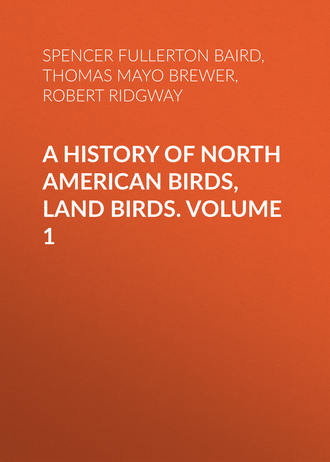 полная версия
полная версияA History of North American Birds, Land Birds. Volume 1
Hab. Eastern North America to Hudson’s Bay and Maine, south (in winter) to Costa Rica and Guatemala. Veragua (Salvin). Not recorded from Mexico or West Indies.
Specimens vary somewhat in purity of tints, and especially in intensity of yellow of under parts, which color is deeper in autumnal skins.
Specimens from Costa Rica and Guatemala, being merely winter visitors to that region, are quite identical with North American examples.
Habits. This but little known species was first described by Mr. Cassin, in 1851, from a specimen shot by him in some woods near Philadelphia nine years previously, which was then unique, and remained so for some time after. This fact, and its resemblance to V. gilva, led to the impression that it might be only a variety of that species. Since the publication of the description other specimens have been procured from different localities,—Moose Factory, Maine, Ohio, Wisconsin, Costa Rica, and Guatemala. But little is as yet known in regard to its habits or its distribution. It is quite abundant in the spring in Southern Wisconsin, where it appears only as a migrant passing north, none remaining to breed. As it makes its appearance late in May, and usually passes rapidly on, it seems natural to infer that it cannot be far from its breeding-place at the period of its appearance. The specimen obtained by Mr. Cassin was shot in September, on its southward journey. It was in the upper branches of a high tree, capturing insects; and his attention was drawn to it by its slow and deliberate movements.
Mr. Thure Kumlien, of Dane County, Wis., informs me that he has been familiar with this Vireo since 1849, and has collected it every year since that period, finding it both in the spring and fall. It appears occasionally as early as the 10th of May, the time varying with the season from the 10th to the 27th. In 1857, when the season was very backward and May very cold, they did not arrive until June 2. They were unusually numerous, and remained only a day or two. So far as he has been able to ascertain, none stop to breed. They are very quiet, have no song at the time they are passing, and seem only intent on collecting their food and in proceeding on their way. They are very tame and unsuspecting, and one can readily get to within a few feet of them. In the fall they are returning south from the 7th to the 19th of September.
The nest and eggs remain to be obtained.
Vireosylvia gilvus, CassinWARBLING GREENLETMuscicapa gilva, Vieill. Ois. I, 1807, 65, pl. xxxiv. Vireo gilvus, Bon. Obs. Wils. 1825, No. 123.—Aud. Orn. Biog. II, pl. cxviii.—Ib. Birds Am. IV, pl. ccxli.—Baird, Birds N. Am. 1858, 335.—Samuels, Birds N. Eng. 273. Vireosylvia gilva, Cassin, Pr. A. N. Sc. 1851, 153.—Sclater, P. Z. S. 1856, 298 (Cordova); (?) 1858, 302 (Oaxaca; June) (perhaps V. swainsoni).—Baird, Rev. Am. B. 342. Muscicapa melodia, Wils. Am. Orn. V, 1812, 85, pl. xlii, fig. 2.
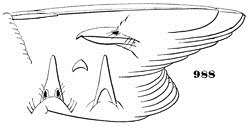
Vireo gilvus.
988
Sp. Char. (No. 1,017 ♀) Above olive-green, strongly glossed with ashy; the head and nape above more distinctly ashy, but without decided line of demarcation behind, and without dusky edge; rump pure olive. Stripe from nostrils over eye to nape, eyelids, and space below eye, creamy-white. A rather dusky post-ocular and loral spot, the latter not extending to the bill. Under parts white, with tinge of greenish-yellow (occasionally of creamy fulvous or buff), especially on breast; sides more olivaceous. Crissum and axillars scarcely more yellowish. Quills and rectrices wood-brown, edged internally with whitish, externally with olivaceous, except perhaps on longer primaries. Edge of wing white. Larger wing-coverts grayish-brown, with paler edges, and no trace of olivaceous. Bill horn-color above, paler below.
First quill very short or spurious; second about equal to, generally rather longer than sixth; third longest; fourth, then fifth a little shorter.
Fresh specimen: Total length, 5.33; expanse of wings, 8.35; wing from carpal joint 2.85. Prepared specimen: Total length, 4.80; wing, 2.75; tail, 2.25. Sexes alike. Iris brown.
Hab. Eastern North America to Fort Simpson. Cordova and Oaxaca only southern localities recorded. Not West Indian.
A very young bird has a very cottony plumage, and differs in tints, having the top of the head and the nape a soft whitish isabella-color, this tingeing the back; the lower parts are wholly unsoiled white; the middle and secondary coverts are obscurely tipped with light brown, forming two indistinct bands across the wing.
A specimen (No. 54,262) from Orizaba is, in positively every respect, exactly intermediate between this species and V. josephæ of Costa Rica, Ecuador, etc. (See footnote on page 360.) The crown is brown, decidedly darker than, and different in tint from, the back, but less so than in josephæ; the back is less olive than in the latter, and less gray than in the former. The lower parts are more yellow than in gilvus, and less so than in josephæ, the superciliary stripe whiter and extending farther back than in the former, and less pure white and shorter than in the latter, etc.
Habits. The Warbling Vireo has only a slightly less extended distribution than the Red-eyed, being found throughout all Eastern North America, as far north as Fort Simpson and Selkirk Settlement, and west to the Missouri River, and breeding as far south as Louisiana. It is stated by Audubon to be found on the Columbia River, but in this he probably referred to the Western race, V. swainsoni. That writer never observed this species in Louisiana or Kentucky, nor in the maritime part of Georgia, and its manner of entering the United States he was unable to ascertain. Where it moves to in the winter is also unknown, none having been met with in the West Indies, and only at a few points in Mexico, Cordova, Oaxaca, and the State of Vera Cruz. It was, however, found breeding at Calcasieu, Louisiana, by Mr. Würdemann.
It breeds abundantly from Virginia to Nova Scotia, and throughout the Northwestern States. West of the Rocky Mountains it is replaced by a closely allied species, the V. swainsoni. This Vireo, more than any other of its genus, if not exclusively, is to a large extent a resident of villages, towns, and even cities. It is by far the sweetest singer that ventures within their crowded streets and public squares,—although Mr. Cassin gives his preference to the notes of the Red-eyed,—and the melody of its song is exquisitely soft and beautiful. It is chiefly to be found among the tall trees, in the vicinity of dwellings, where it seems to delight to stay, and from their highest tops to suspend its pensile nest. It is especially abundant among the elms on Boston Common, where at almost any hour of the day, from early in the month of May until long after summer has gone, may be heard the prolonged notes of this, one of the sweetest and most constant of our singers. Its voice is not powerful, but its melody is flute-like and tender. Throughout the last of May, and in June and July, their charming song may be heard amid the din of the city from earliest dawn till nightfall, and rarely ceases even in the noontide heat, when all other birds are silent. It is ever in motion, while thus singing; and its sweetest notes are given forth as it moves among the tree-tops in search of insects. It is not only one of our most constant singers, but it remains musical almost until its departure for the South in October.
The Warbling Vireo appears in the Middle States about the 15th of April, and reaches New England early in May. The path of its northern migrations, and of its return, is somewhat in doubt. It is abundant in winter, according to Sumichrast, about Orizaba, and probably enters Texas and passes north and east along the Mississippi and the Ohio Rivers. In certain portions of the country this species is evidently on the increase, becoming more and more common as the country is settled, and towns and villages spring up.
The Warbling Vireo builds its nest usually in more elevated positions than any others of this family. For the most part in the vicinity of dwellings, often over frequented streets, they suspend their elaborately woven and beautiful little basket-like nest, secure from intrusion from their human neighbors, and protected by the near presence of man from all their more dreaded enemies. Audubon narrates, in an interesting manner, the building of their nest by a pair of these birds on a poplar-tree, near his window, in Camden, N. J. It was suspended between the body of the tree and a branch coming out at an acute angle. The pair were at work, morning and evening, eight days, first attaching slender blades of grass to the knots on the branch and the bark of the trunk, and thence working downward and outward. They varied their materials, from time to time, until at last he traced them, after a prolonged absence, to a distant haystack, from which they brought fine, slender, dry grasses, with which they completed and lined their nest.
The nests of the Warbling Vireo, while they resemble closely those of the other species in all the characteristics of this well-marked family, are yet, as a rule, more carefully, neatly, and closely built. They are usually suspended at the height of from thirty to fifty feet, in the fork of twigs, under and near the extremity of the tree-top, often an elm, protected from the sun and storm by a canopy of leaves, and quite out of reach of most enemies. They vary little in size, being about two inches in height and three and a half in their greatest diameter, narrowing, toward their junction with the twigs, to two inches. They are all secured in a very firm manner to the twigs from which they are suspended by a felting of various materials, chiefly soft, flexible, flax-like strips of vegetable fibres, leaves, stems of plants, and strips of bark. With these are interwoven, and carried out around the outer portions of the nest, long strips of soft flexible bark of deciduous trees. They are softly and compactly filled in and lined with fine stems of plants.
The eggs are usually five in number, and, like those of all the Vireos, are of a brilliant crystal-white, sparingly spotted at the larger end with markings of dark brown, and others of a lighter shade. They are less marked with spots than usual in the genus, and are often entirely unspotted, and pure white. Occasionally, however, they are found with well-marked blotches of reddish-brown. They vary in length from .75 to .70 of an inch, and average about .55 in their breadth.
Vireosylvia gilvus, var. swainsoni, BairdWESTERN WARBLING GREENLETVireo swainsoni, Baird, Birds N. Am. 1858, 336 (Pacific coast).—Elliot, Illust. Birds N. A. I, vii. Vireosylvia swainsoni, Baird, Rev. Am. B. 343. Vireosylvia gilva, var. swainsoni, Cooper, Orn. Cal. 1, 1870, 116. Vireo bartramii, Swainson, F. B. A. II, 1831, 235 (in part; spec. from Columbia River?).

Vireo swainsoni.
12891
(No. 5,321 ♂.) Similar to V. gilva, but smaller; colors paler. Bill more depressed. Upper mandible almost black. Second quill much shorter than sixth. Total length, 4.75; wing, 2.71; tail, 2.35; difference between tenth quill and longest, .58; exposed portion of first primary, .58, of second, 1.82, of longest (measured from exposed base of first primary), 2.10; length of bill from forehead, .56, from nostril, .29, along gape, .65; depth of bill, .13; tarsus, .70; middle toe and claw, .56; hind toe and claw, .43.
Hab. United States, from Rocky Mountains to Pacific coast.
In the present bird the bill is darker in color, much smaller, and more depressed, the depth at the base being less than the width, instead of being equal to it as in var. gilvus. The wing is more rounded, the second quill much shorter than the sixth, generally shorter or but little longer than the seventh. In var. gilvus, the second quill is about equal to the sixth. The second quill is about .30 of an inch (or more) shorter than the longest in swainsoni, while in gilvus it is only about .20 shorter. The feet of swainsoni are weaker, and the colors generally paler and grayer. The iris, according to Coues, is dark brown.
Young birds in autumnal plumage have the crown decidedly ash, the sides more greenish; the wing-coverts pass terminally into a light brownish tint, producing an inconspicuous band.
Habits. This Western representative of the Warbling Vireo is found throughout the western portions of our Union, from the Great Plains to the Pacific, and from Arizona to the extreme northern boundary of Washington Territory.
Dr. Cooper characterizes this as a lively and familiar songster. It arrives, he states, at San Diego about April 10, and reaches Puget Sound toward the middle of May, occupying nearly all the intermediate country throughout the summer. It frequents the deciduous trees along the borders of streams and prairies, coming into gardens and orchards with familiar confidence, wherever cultivation has reclaimed the wilderness. Like its Eastern prototype, its cheerful and varied song is heard all day long until quite late in the autumn. They too build their nests in the shade-trees of the parks of busy cities, singing ever their delightful strains, unconscious of the busy and noisy crowd that throngs the neighboring streets.
Dr. Cooper states that its nests are pendent from the forks of a branch high above the ground, sometimes to the height of a hundred feet.
Mr. Ridgway, who observed the habits of this species in Utah and Nevada, speaks of it as the characteristic Vireo of the West. It was found by him in all the fertile localities, and was one of the most common birds in the wooded regions. He found it very generally distributed through the summer, inhabiting the copses along the streams of the mountain cañons, and the open groves of the parks, as well as the cottonwoods and willows of the river valleys. In the fall the berries of a species of the cornel that grows along the mountain streams constitute its principal food. Its notes and manners are identical with those of the Eastern species.
The nests of this species are not distinguishable, except in the necessarily varying materials, from those of the Eastern birds. In position, size, and shape they are the same. The eggs, four or five in number, are white, spotted with brown and reddish-brown, and measure .78 by .58 of an inch. The spots are somewhat darker than those of the V. gilvus, and the shape more of an oblong-oval, in all that I have seen. But this difference may disappear in the examination of a larger number.
A nest found by Mr. Ridgway near Fort Churchill, Nevada, June 24, was suspended from the extremity of a twig of a sapling of the cottonwood, in a copse of the same growing in a river-bottom. It has a height of two and a half inches, and a diameter of three. It is composed externally of an elaborate interweaving of spiders’-webs, willow and cottonwood down, and strong cord-like strips of fine inner bark. These are strongly bound around the twigs from which the nest is suspended. It is one of the most elaborately interwoven, homogeneous, and well-felted nests of this bird I have ever met with. Another nest, from Parley’s Park, Utah, obtained June 28, differs in having the external portion woven almost exclusively of fine strips of bleached bark, and is lined with fine wiry grasses. In each of these the eggs were four in number, all oblong-oval in shape, but much more pointed at one end in the latter nest.
This species was found breeding in Napa Valley, Cal., by Mr. A. J. Grayson, and at Fort Tejon by Mr. Xantus.
Subgenus LANIVIREO, BairdChar. Body stout, head broad. Bill short and stout, broad at the base, the culmen curved from the base, the commissure considerably arched. Bill blue-black. Feet stout. Type, V. flavifrons. For figure, see page 379.
Species and VarietiesCommon Characters. A broad stripe from bill to and around, but not beyond, the eye. Two broad white bands across the wings. Bill plumbeous-blue, black toward culmen. Iris brown in all species?
1. L. solitarius. Spurious primary exposed. Throat and orbital ring white.
a. Spurious primary well developed,—.60 or more long, .10 broad.
Nape and side of neck plumbeous; upper tail-coverts olive-green. Crissum tinged with yellow, but none on side of throat, nor across breast. Wing, 3.05; tail, 2.40; bill, from nostril, .27; tarsus, .66. Hab. Eastern Province of United States, straggling westward to the Pacific Coast, especially in its migration southward into Mexico, where it penetrates in winter as far as Guatemala … var. solitarius.
Above continuous olive-brown; below ochraceous-white, with a buffy tinge across breast, and deeply olivaceous along sides. Crissum tinged with yellow. Wing, 2.80; tail, 2.15; bill, 30; tarsus, 66. Hab. Pacific Province of United States, straggling in autumn eastward into the Middle Province … var. cassini.
Above continuous ashy-plumbeous. Beneath pure white, ashy along sides, and very slightly so across breast. Wing, 3.25; tail, 2.50; bill, .30; tarsus, .66. Hab. Middle Province of United States, south, in winter, through Western Mexico to Colima … var. plumbeus.
b. Spurious primary very minute,—about .30 long by .04 wide.
Nape and side of neck olive-green; upper tail-coverts plumbeous. Crissum not tinged with yellow, but sides of the throat and across the breast are. Wing, 3.10; tail. 2.20; bill, .29; tarsus, .64. Hab. Coban, Vera Cruz, Guatemala; resident? … var. propinquus.77
2. L. flavifrons. Spurious primary concealed. Throat and orbital ring yellow.
Anterior half of body olive-green above, lemon-yellow below; posterior half plumbeous-ash above, white below. Wing, 3.00; tail, 1.90; bill, .32; tarsus, .70. Hab. Eastern Province of United States, south, in winter, to Costa Rica, and very rare in Cuba.
Lanivireo solitarius, BairdBLUE-HEADED VIREOMuscicapa solitaria, Wils. Am. Orn. II, 1810, 143, pl. xvii, fig. 6. Vireo solitarius, Vieill.—Aud. I.—Cassin, Sc.—Sclater, P. Z. S. 1856, 298 (Cordova); 1859, 363 (Xalapa); 375 (Oaxaca?).—Sclater & Salvin, Ibis, 1860, 31 (Guatemala).—Cab. Jour. III, 468 (Cuba).—Gundlach, Cab. Jour. 1861, 324 (Cuba; very rare).—Samuels, Birds N. Eng. 277. Vireo (Lanivireo) sol. Baird, Birds N. Am. 1858, 329. Vireosylvia (Lanivireo) solitaria, Baird, Rev. Am. B. 1864, 347.
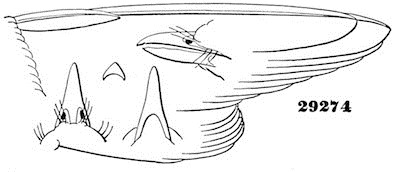
Lanivireo solitarius.
29274
Sp. Char. (No. 300 ♂.) Above olive-green, including upper tail-coverts; the top and sides of head and nape ashy-plumbeous; sides of the neck plumbeous-olive. Broad line from nostrils to and around eye, involving the whole lower eyelid, white. A loral line involving the edge of the eyelid, and a space beneath the eye, dusky plumbeous. Beneath white; the sides yellow, overlaid with olive, this color not extending anterior to the breast. Axillars and base of crissum pale sulphur-yellow, the long feathers of the latter much paler or nearly white. Wings with two bands and outer edges of innermost secondaries olivaceous-white; the quills dark brown, edged externally with olive-green, internally with white; tail-feathers similarly marked, except that the lateral feather is edged externally also with white, the central without internal border. Bill and legs blackish-plumbeous. Iris brown.
First quill spurious, rather more than one fifth the second, which is intermediate between the fifth and sixth; third longest.
Fresh specimen: Total length, 5.40; expanse of wing, 9.00. Prepared specimen: Total length, 5.25; wing, 2.95: tail, 2.35.
Hab. United States, from Atlantic to Pacific; Cape St. Lucas. Not recorded from Southern Rocky Mountains, where replaced by L. plumbeus. South to Mexico and Guatemala. Vera Cruz (winter, Sumichrast). Very rare in Cuba.
Spring specimens show sometimes a gloss of plumbeous on the back, obscuring the olive, the contrast of colors being greater in the autumnal and young birds. Sometimes the crissum appears nearly white. The length of the spurious primary varies considerably, from .45 to .75 of an inch.
In autumn the colors are similar, but slightly duller and less sharply defined, while the back is considerably tinged with ashy.
Habits. The Solitary Vireo appears to be found, irregularly, throughout the United States. Nowhere abundant, so far as I am aware, it seems to be more common in California than on the Atlantic, while there are also large tracks of intervening territory in which we have no knowledge of its presence. On the Atlantic it has been met with from Georgia to the Bay of Fundy. In Massachusetts it has been found in a few restricted localities; in one or two of them, they are as abundant as the White-eyed. Mr. Dresser found it in Texas, near San Antonio, late in the autumn, and early in spring, but none remained to breed. Mr. Boardman gives them as a summer visitant at Calais, but not common, and Professor Verrill makes a similar statement for Western Maine, where it arrives in the second week of May. According to Mr. Allen, it reaches Western Massachusetts by May 1, but it is there quite rare. A few are presumed to stop and breed.
In California, Mr. Gambel states that it is quite abundant in the latter part of summer, and throughout the winter, frequenting low bushes and thickets. Dr. Heermann also frequently met with it. Both at the East and the West it is undoubtedly only migratory to about the 40th parallel, and does not, except in mountainous localities, breed south of that line. Professor Baird found it breeding in the South Mountains, near Carlisle, Penn., in May, 1844. It occurs in Guatemala in the winter.
Dr. Cooper states that it reaches Puget Sound by the first of May, and he has also observed it in the Colorado Valley, after the 14th, where they made themselves conspicuous by their song, but in a few days had all passed northward. He has met them nesting in May at the eastern base of the Coast Range, and has also found them quite common, in summer, on the Columbia River. Their favorite resorts are the deciduous oaks.
These birds were found breeding at Fort Tejon by Mr. Xantus, and at Vancouver by Mr. Hepburn.
Mr. Ridgway met with a few in September, in the thickets along the streams flowing from the Clover Mountains.
This species was taken in winter by Mr. Boucard, at Talew, in the State of Oaxaca, Mexico.
Mr. Audubon’s statement that this bird is rather abundant, and that it breeds in Louisiana, is undoubtedly incorrect, and his description of its nest and eggs belongs rather to the Yellow-throated, and agrees with none that I have ever seen of this species. That he found them abundant in Maine, and traced them as far north as Pictou, Nova Scotia, is more probable. Dr. Bachman speaks of this species becoming each year more abundant in South Carolina, coming in February and remaining through March.
Mr. Nuttall, who met with this species on the Columbia, about the beginning of May, describes its song as a plaintive, deliberate warble, intermediate between the song of the olivaceus and the flavifrons. Mr. Burroughs describes the love-notes of these birds as being inexpressibly sweet and tender in both sexes. The song of the male, as I have heard it, bears no resemblance to that of any other Vireo. It is a prolonged and very peculiar ditty, repeated at frequent intervals and always identical. It begins with a lively and pleasant warble, of a gradually ascending scale, which at a certain pitch suddenly breaks down into a falsetto note. The song then rises again in a single high note, and ceases. For several summers the same bird has been heard, near my house in Hingham, in a wild pasture, on the edge of a wood, always singing the same singular refrain, during the month of June.




